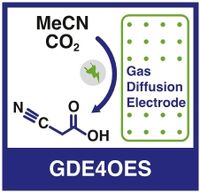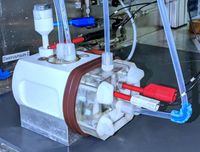GDE4OES Laplace pressure controlled gas diffusion electrodes for organic electrosynthesis |
Electrochemical cell for testing gas diffusion electrodes. (Source: Chair of Power-to-X Technologies / FAU Erlangen-Nuremberg)
Motivation: The conversion of gases such as CO2, N2 or O2 is a major challenge in synthetic organic chemistry. Here, electrochemistry offers possibilities since reactions can be carried out in a wide potential window. An obstacle to a broad technical applicability is the low supply of dissolved gases at the electrode. This problem is known in detail for aqueous electrolytes and can be solved here by using so-called gas-diffusion electrodes (GDEs). In GDEs, hydrophobic materials maintain a large phase boundary between the liquid electrolyte, solid electrode, and the gas phase which is combined with low diffusion pathways. For organic electrolytes, this cannot be used so far due to the smaller wetting differences and technical GDE concepts are lacking.
Aims und methodology: GDE4OES aims to address this challenge by adjusting the position of the phase boundary within complex and possibly hierarchically structured electrode networks via the differential pressure between gas and liquid phases. The structure of the electrode as well as the operating parameters and the cell concept will be developed. For this purpose, the partners combine competences in the fabrication of complex metal network structures, material characterization, deposition of catalytic layers, electrochemical testing and characterization, modeling of electrochemical systems and mathematical optimization. The electrocarboxylation of acetonitrile to cyanoacetic acid serves as an example reaction, which will be investigated on steel, nickel, and platinum networks.
Innovations and perspectives: Through the research and development within GDE4OES, the generation of gaseous reactants will be enabled. In addition to the innovation for the specific target reaction, both laboratory cells and electrode concepts are to be developed, which will also facilitate the investigation of further reactions beyond the electrocarboxylation of acetonitrile.
Coordinator:
Bastian Etzold (FAU Erlangen-Nürnberg) bastian.etzold@fau.de
Project partners:
FAU Erlangen-Nürnberg
Gaskatel Gesellschaft für Gassysteme durch Katalyse und Elektrochemie mbH
Karlsruher Institut für Technologie (KIT)
Technische Universität Darmstadt
Umicore AG & Co. KG

